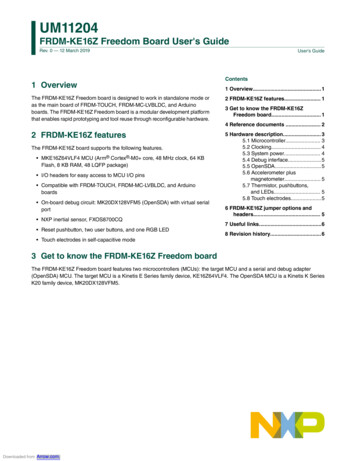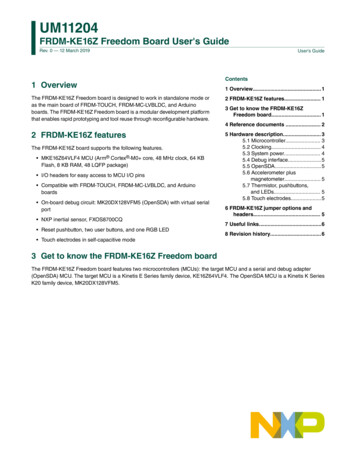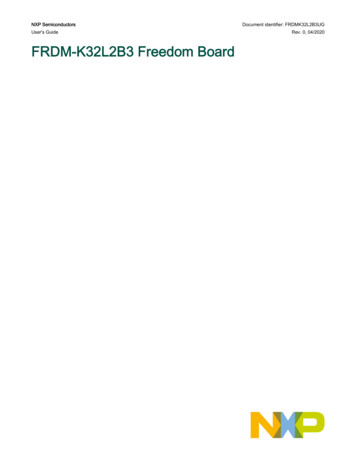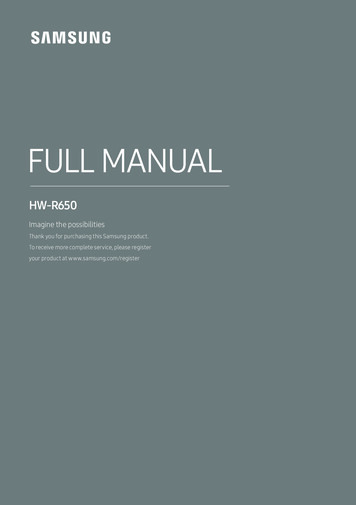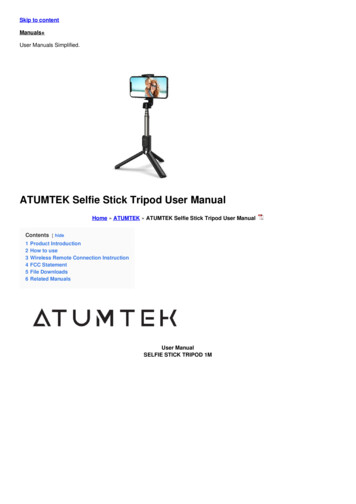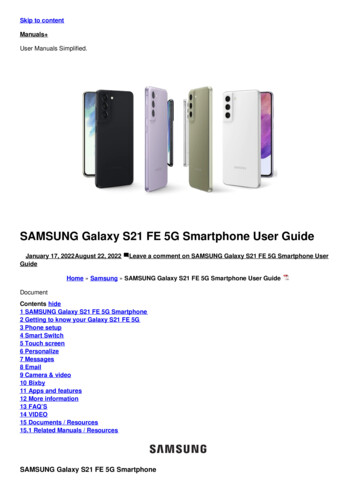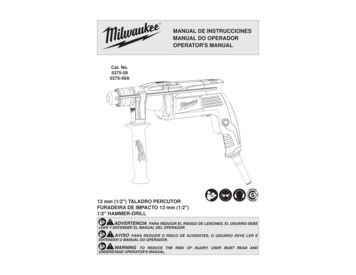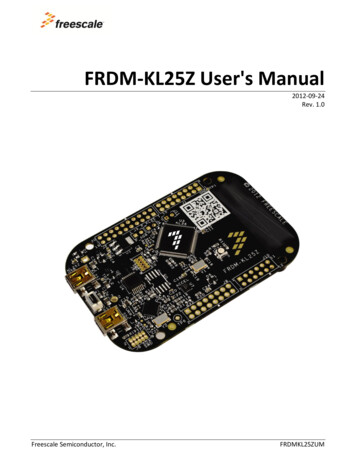
Transcription
FRDM-KL25Z User's Manual2012-09-24Rev. 1.0Freescale Semiconductor, Inc.FRDMKL25ZUM
Table of Contents1 Overview .32 Reference Documents .33 Getting Started.34 FRDM-KL25Z Hardware Overview .45 FRDM-KL25Z Hardware Description .55.1 Power Supply. 55.2 Serial and Debug Adapter (OpenSDA) . 75.2.1 Debug Interface . 75.2.2 Virtual Serial Port. 85.3 KL25Z Microcontroller . 85.3.1 Clock Source . 95.3.2 USB Interface . 95.3.3 Serial Port . 95.3.4 Reset. 95.3.5 Debug . 105.4 Capacitive Touch Slider . 105.5 3-axis Accelerometer. 105.6 RGB LED. 105.7 Input/Output Connectors. 115.8 Arduino Compatibility . 12FRDMKL25ZUMFRDM-KL25Z User's ManualPage 2 of 14
1 OverviewThe Freescale Freedom development platform is a set of software and hardware tools for evaluationand development. It is ideal for rapid prototyping of microcontroller-based applications. The FreescaleFreedom KL25Z hardware, FRDM-KL25Z, is a simple, yet sophisticated design featuring a Kinetis L seriesmicrocontroller, the industry’s first microcontroller built on the ARM Cortex -M0 core.FRDM-KL25Z can be used to evaluate the KL1 and KL2 Kinetis L series devices. It features aKL25Z128VLK, a KL2 family device boasting a max operating frequency of 48MHz, 128KB of flash, a fullspeed USB controller, and loads of analog and digital peripherals. The FRDM-KL25Z hardware is formfactor compatible with the Arduino R3 pin layout, providing a broad range of expansion boardoptions. The on-board interfaces include an RGB LED, a 3-axis digital accelerometer, and a capacitivetouch slider.The FRDM-KL25Z is the first hardware platform to feature the Freescale open standard embeddedserial and debug adapter known as OpenSDA. This circuit offers several options for serialcommunications, flash programming and run-control debugging.2 Reference DocumentsThe table below provides a list of reference documents for the FRDM-KL25Z hardware. All of thesedocuments are available online at www.freescale.com/FRDM-KL25Z.Table 1. FRDM-KL25Z Reference DocumentsFilenameFRDM-KL25Z Quick Start PackageFRDM-KL25Z User’s ManualFRDM-KL25Z PinoutsFRDM-KL25Z SchematicsFRDM-KL25Z Design PackageOpenSDA User’s GuideDescriptionQuick Start Guide and supporting files for getting started withthe FRDM-KL25Z.This document—overview and detailed information for theFRDM-KL25Z hardware.Spreadsheet of pin connections for all MCU pins. Includespinout for the I/O headers, Arduino R3 compatibility chart,and OpenSDA MCU pinout.PDF schematics for the FRDM-KL25Z hardwareZip file containing all design source files for the FRDM-KL25ZhardwareOverview and instructions for use of the OpenSDA embeddeddebug circuit3 Getting StartedRefer to the FRDM-KL25Z Quick Start Package for step-by-step instructions for getting started with theFRDM-KL25Z. See the Jump Start Your Design section onwww.freescale.com/FRDM-KL25Z for theQuick Start Package and software lab guides.FRDMKL25ZUMFRDM-KL25Z User's ManualPage 3 of 14
4 FRDM-KL25Z Hardware OverviewThe features of the FRDM-KL25Z include: MKL25Z128VLK4 in an 80 LQFP package Capacitive touch slider MMA8451Q accelerometer Tri-color (RGB) LED Flexible power supply options – USB, coin cell battery, external source Battery-ready, power-measurement access points Easy access to MCU I/O via Arduino R3 compatible I/O connectors Programmable OpenSDA debug interface with multiple applications available including:- Mass storage device flash programming interface- P&E Debug interface provides run-control debugging and compatibility with IDE tools- CMSIS-DAP interface: new ARM standard for embedded debug interface- Data logging applicationFigure 1 shows a block diagram of the FRDM-KL25Z design. The primary components and theirplacement on the hardware assembly are pointed out in Figure 2.Figure 1. FRDM-KL25Z Block DiagramFRDMKL25ZUMFRDM-KL25Z User's ManualPage 4 of 14
Figure 2. FRDM-KL25Z Feature Call-outs5 FRDM-KL25Z Hardware Description5.1 Power SupplyThere are multiple power supply options on the FRDM-KL25Z. It can be powered from either of theUSB connectors, the VIN pin on the I/O header, an on-board coin cell battery, or an off-board 1.71-3.6Vsupply from the 3.3V pin on the I/O header. The USB and V IN supplies are regulated on-board using a3.3V linear regulator to produce the main power supply. The other two sources are not regulated onboard. Table 2 provides the operational details and requirements for the power supplies.Table 2. Power Supply RequirementsFRDMKL25ZUMSupply SourceValid RangeOpenSDA USB (J7)KL25Z USB (J5)VIN Pin3.3V PinCoin Cell nal?YesNoNoNoNoFRDM-KL25Z User's ManualRegulated onboard?YesYesYesNoNoPage 5 of 14
Note that the OpenSDA circuit is only operational when a USB cable is connected and supplying powerto J7. However, protection circuitry is in place to allow multiple sources to be powered at once.Figure 3 shows the schematic drawing for the power supply inputs and the on-board voltage regulator.Figure 3. Power Supply SchematicTable 3. FRDM-KL25Z Power SuppliesPower Supply NameP5-9V VINP5V SDAP5V KL25ZP3V3 VREGP3V3 BATTP3V3P3V3 KL25ZP3V3 SDAP5V USBDescriptionPower supplied from the VIN pin of the I/O headers (J9 pin 16).Power supplied from the OpenSDA USB connector (J7). A Schottkydiode provides back drive protection.Power supplied from the KL25Z USB connector (J5). A Schottky diodeprovides back drive protection.Regulated 3.3V supply. Sources power to the P3V3 supply railthrough a back drive protection Schottky diode. 1Coin cell battery supply voltage. Sources power to the P3V3 supplyrail through a back drive protection Schottky diode.Main supply rail for the FRDM-KL25Z assembly. May be sourced fromP3V3 VREG, P3V3 BATT, or directly from the I/O headers (J9 pin 8)KL25Z MCU supply. Header J4 provides a convenient means forenergy consumption measurements. 2OpenSDA circuit supply. Header J3 provides a convenient means forenergy consumption measurements. 2Nominal 5V supplied to the I/O headers (J9 pin 10). Sourced fromeither the P5V KL25Z or P5V OSDA supply through a back driveprotection Schottky diode.NOTES:1) By default the linear regulator, U1, is a 3.3V output regulator. However, this is acommon footprint that would allow the user to modify the assembly to utilize anFRDMKL25ZUMFRDM-KL25Z User's ManualPage 6 of 14
alternative device such as a 1.8V or 2.5V regulator. The KL25Z microcontroller has anoperating range of 1.71V to 3.6V.2) J3 and J4 are not populated by default. The two pins of these headers are shortedtogether by a trace on the bottom layer of the PCB. To measure the energyconsumption of either the KL25Z or the OpenSDA MCU, the trace between these pinsmust first be cut. A current probe or a shunt resistor and voltage meter can then beapplied to measure the energy consumption on these rails.5.2 Serial and Debug Adapter (OpenSDA)OpenSDA is an open-standard serial and debug adapter. It bridges serial and debug communicationsbetween a USB host and an embedded target processor as shown in Figure 4. The hardware circuit isbased on a Freescale Kinetis K20 family microcontroller (MCU) with 128 KB of embedded flash and anintegrated USB controller. OpenSDA features a mass storage device (MSD) bootloader, which providesa quick and easy mechanism for loading different OpenSDA Applications such as flash programmers,run-control debug interfaces, serial-to-USB converters, and more. Refer to the OpenSDA User’s Guidefor more details.Figure 4. OpenSDA High-Level Block DiagramOpenSDA is managed by a Kinetis K20 MCU built on the ARM Cortex -M4 core. The OpenSDA circuitincludes a status LED (D4) and a pushbutton (SW1). The pushbutton asserts the Reset signal to theKL25Z target MCU. It can also be used to place the OpenSDA circuit into Bootloader mode. SPI andGPIO signals provide an interface to either the SWD debug port of the KL25Z. Additionally, signalconnections are available to implement a UART serial channel. The OpenSDA circuit receives powerwhen the USB connector J7 is plugged into a USB host.5.2.1 Debug InterfaceSignals with SPI and GPIO capability are used to connect directly to the SWD of the KL25Z. Thesesignals are also brought out to a standard 10-pin (0.05”) Cortex Debug connector (J6). It is possible toisolate the KL25Z MCU from the OpenSDA circuit and use J6 to connect to an off-board MCU. ToFRDMKL25ZUMFRDM-KL25Z User's ManualPage 7 of 14
accomplish this, cut the trace on the bottom side of the PCB that connects J11 pin 1 to J11 pin 2. Thiswill disconnect the SWD CLK pin to the KL25Z so that it will not interfere with the communications toan off-board MCU connected to J6.Figure 5. SWD Debug ConnectorNote that J6 is not-populated by default. A Samtec FTSH-105-02-F-D or compatible connector can beadded to the J6 through-hole connector. A mating cable, such as a Samtec FFSD IDC cable, can then beused to connect from the OpenSDA of the FRDM-KL25Z to an off-board SWD connector.5.2.2 Virtual Serial PortA serial port connection is available between the OpenSDA MCU and pins PTA1 and PTA2 of the KL25Z.Several of the default OpenSDA Applications provided by Freescale, including the MSD FlashProgrammer and the P&E Debug Application, provide a USB Communications Device Class (CDC)interface that bridges serial communications between the USB host and this serial interface on theKL25Z.5.3 KL25Z MicrocontrollerThe target microcontroller of the FRDM-KL25Z is the KL25Z128VLK4, a Kinetis L series device in an 80LQFP package. The KL25Z MCU features include: 32-bit ARM Cortex-M0 core- up to 48 MHz operation- Single-cycle fast I/O access port Memories- 128 KB flash- 16 KB SRAM System integration- Power management and mode controllers- Low-leakage wakeup unit- Bit manipulation engine for read-modify-write peripheral operations- Direct memory access (DMA) controller- Computer operating properly (COP) Watchdog timer Clocks- Clock generation module with FLL and PLL for system and CPU clock generationFRDMKL25ZUMFRDM-KL25Z User's ManualPage 8 of 14
- 4 MHz and 32 kHz internal reference clock- System oscillator supporting external crystal or resonator- Low-power 1kHz RC oscillator for RTC and COP watchdogAnalog peripherals- 16-bit SAR ADC w/ DMA support- 12-bit DAC w/ DMA support- High speed comparatorCommunication peripherals- Two 8-bit Serial Peripheral Interfaces (SPI)- USB dual-role controller with built-in FS/LS transceiver- USB voltage regulator- Two I2C modules- One low-power UART and two standard UART modulesTimers- One 6-channel Timer/PWM module- Two 2-channel Timer/PWM modules- 2-channel Periodic Interrupt Timer (PIT)- Real time clock (RTC)- Low-power Timer (LPT)- System tick timerHuman-Machine Interfaces (HMI)- General purpose input/output controller- Capacitive touch sense input interface hardware module5.3.1 Clock SourceThe Kinetis KL2 microcontrollers feature an on-chip oscillator compatible with three ranges of inputcrystal or resonator frequencies: 32-40 kHz (low freq. mode), 3-8 MHz (high freq. mode, low range) and8-32 MHz (high freq. mode, high range). The KL25Z128 on the FRDM-KL25Z is clocked from an 8 MHzcrystal.5.3.2 USB InterfaceThe Kinetis KL2 microcontrollers feature a dual-role USB controller with on-chip full-speed and lowspeed transceivers. The USB interface on the FRDM-KL25Z is configured as a full-speed USB device. J5is the USB connector for this interface.5.3.3 Serial PortThe primary serial port interface signals are PTA1 and PTA2. These signals are connected to both theOpenSDA and to the J1 I/O connector.5.3.4 ResetThe PTA20/RESET signal on the KL25Z128 is connected externally to a pushbutton, SW1, and also to theOpenSDA circuit. The reset button can be used to force an external reset event in the target MCU. Thereset button can also be used to force the OpenSDA circuit into bootloader mode. Please refer tosection 5.2, Serial and Debug Adapter (OpenSDA), for more details.FRDMKL25ZUMFRDM-KL25Z User's ManualPage 9 of 14
5.3.5 DebugThe sole debug interface on all Kinetis L Series devices is a Serial Wire Debug (SWD) port. The primarycontroller of this interface on the FRDM-KL25Z is the onboard OpenSDA circuit (see section 5.2).However, an unpopulated 10-pin (0.05”) Cortex Debug connector, J6, provides access to the SWDsignals. The Samtec FTSH-105-02-F-D or compatible connectors can be added to the J6 through-holedebug connector to allow for an external debug cable to be connected.5.4 Capacitive Touch SliderTwo Touch Sense Input (TSI) signals, TSI0 CH9 and TSI0 CH10, are connected to capacitive electrodesconfigured as a touch slider. Freescale’s Touch Sense Software (TSS) provides a software library forimplementing the capacitive touch slider.5.5 3-axis AccelerometerA Freescale MMA8451Q low-power, three-axis accelerometer is interfaced through an I2C bus and twoGPIO signals as shown in Table 4 below. By default, the I2C address is 0x1D (SA0 pulled high).Table 4. Accelerometer Signal 5PTA14PTA15Figure 6. MMA8451Q Schematic Diagram5.6 RGB LEDThree PWM-capable signals are connected to a red, green, blue LED, D3. The signal connections areshown in Table 5 below.FRDMKL25ZUMFRDM-KL25Z User's ManualPage 10 of 14
Table 5. RGB LED Signal ConnectionsRGB LEDRed CathodeGreen CathodeBlue CathodeKL25Z128PTB18PTB19PTD1 1NOTE:1)PTD1 is also connected to the I/O header on J2 pin 10 (also known as D13).Figure 7. RGB LED Schematic Diagram5.7 Input/Output ConnectorsThe KL25Z128VLK4 microcontroller is packaged in an 80-pin LQFP. Some pins are utilized in on-boardcircuitry, but many are directly connected to one of four I/O headers.The pins on the KL25Z microcontroller are named for their general purpose input/output port pinfunction. For example, the 1st pin on Port A is referred to as PTA1. The I/O connector pin names aregiven the same name as the KL25Z pin connected to it, where applicable.FRDMKL25ZUMFRDM-KL25Z User's ManualPage 11 of 14
Note that all pinout data is available in spreadsheet format in FRDM-KL25Z Pinouts. See the ReferenceDocuments section for details.5.8 Arduino CompatibilityThe I/O headers on the FRDM-KL25Z are arranged to allow compatibility with peripheral boards(known as shields) that connect to Arduino and Arduino-compatible microcontroller boards. Theouter rows of pins (the even numbered pins) on the headers share the same mechanical spacing andplacement as the I/O headers on the Arduino Revision 3 (R3) standard.FRDMKL25ZUMFRDM-KL25Z User's ManualPage 12 of 14
Refer to the FRDM-KL25Z Pinouts spreadsheet for a compatibility chart showing how all the functionsof the KL25Z signals on the I/O connectors map to the pin functions available on the Arduino Uno R3.FRDMKL25ZUMFRDM-KL25Z User's ManualPage 13 of 14
How to Reach Us:Home Page:freescale.comWeb Support:freescale.com/supportInformation in this document is provided solely to enable system andsoftware implementers to use Freescale products. There are no express orimplied copyright licenses granted hereunder to design or fabricate anyintegrated circuits or integrated circuits based on the information in thisdocument.Freescale reserves the right to make changes without further notice to anyproducts herein. Freescale makes no warranty, representation or guaranteeregarding the suitability of its products for any particular purpose, nor doesFreescale assume any liability arising out of the application or use of anyproduct or circuit, and specifically disclaims any and all liability, includingwithout limitation consequential or incidental damages. “Typical” parametersthat may be provided in Freescale data sheets and/or specifications can anddo vary in different applications and actual performance may vary over time.All operating parameters, including “Typicals”, must be validated for eachcustomer application by customer’s technical experts. Freescale does notconvey any license under its patent rights nor the rights of others. Freescalesells products pursuant to standard terms and conditions of sale, which canbe found at the following e/Docs/TermsandConditions.htmFreescale, the Freescale logo, Altivec, C-5, CodeTest, CodeWarrior,ColdFire, C Ware, Energy Efficient Solutions logo, Kinetis, mobileGT,PowerQUICC, Processor Expert, QorIQ, Qorriva, StarCore, Symphony, andVortiQa are trademarks of Freescale Semiconductor, Inc., Reg. U.S. Pat. &Tm. Off. Airfast, BeeKit, BeeStack, ColdFire , CoreNet, Flexis, MadniV,MXC, Platform in a Package, QorIQ Qonverge, QUICC Engine, Ready Play,SafeAssure, SMARTMOS, TurboLink, Vybrid, and Xtrinsic are trademarks ofFreescale Semiconductor, Inc. All other product or service names are theproperty of their respective owners. Freescale Semiconductor, Inc. 2012. All rights reserved.FRDMKL25ZUMRev. 0.902012-09-24FRDMKL25ZUMFRDM-KL25Z User's ManualPage 14 of 14
5.2 Serial and Debug Adapter (OpenSDA) OpenSDA is an open-standard serial and debug adapter. It bridges serial and debug communications between a USB host and an embedded target processor as shown in Figure 4. The hardware circuit is based on a Freescale Kinetis K20 family microcontroller (MCU) with 128 KB of embedded flash and an
